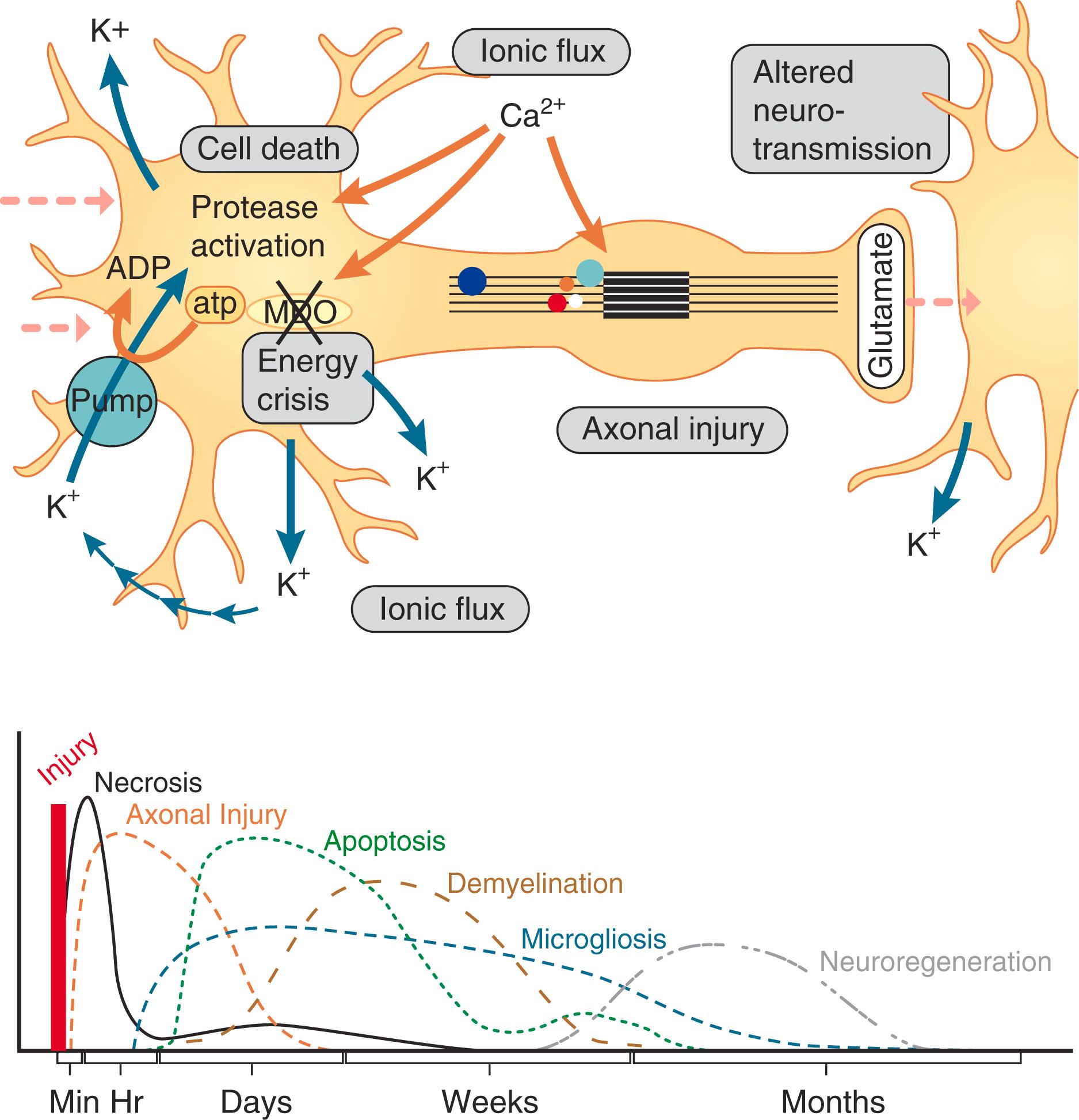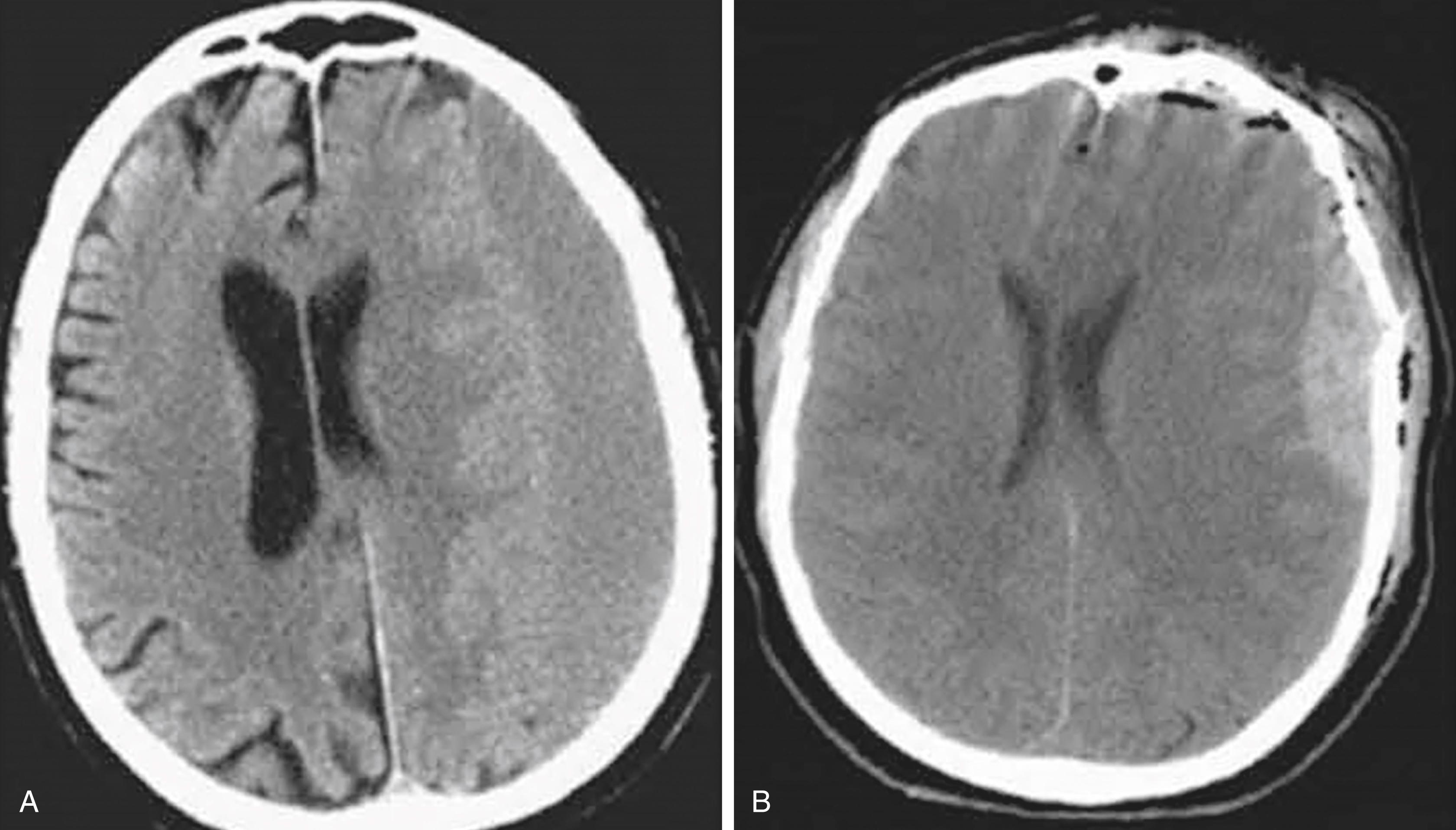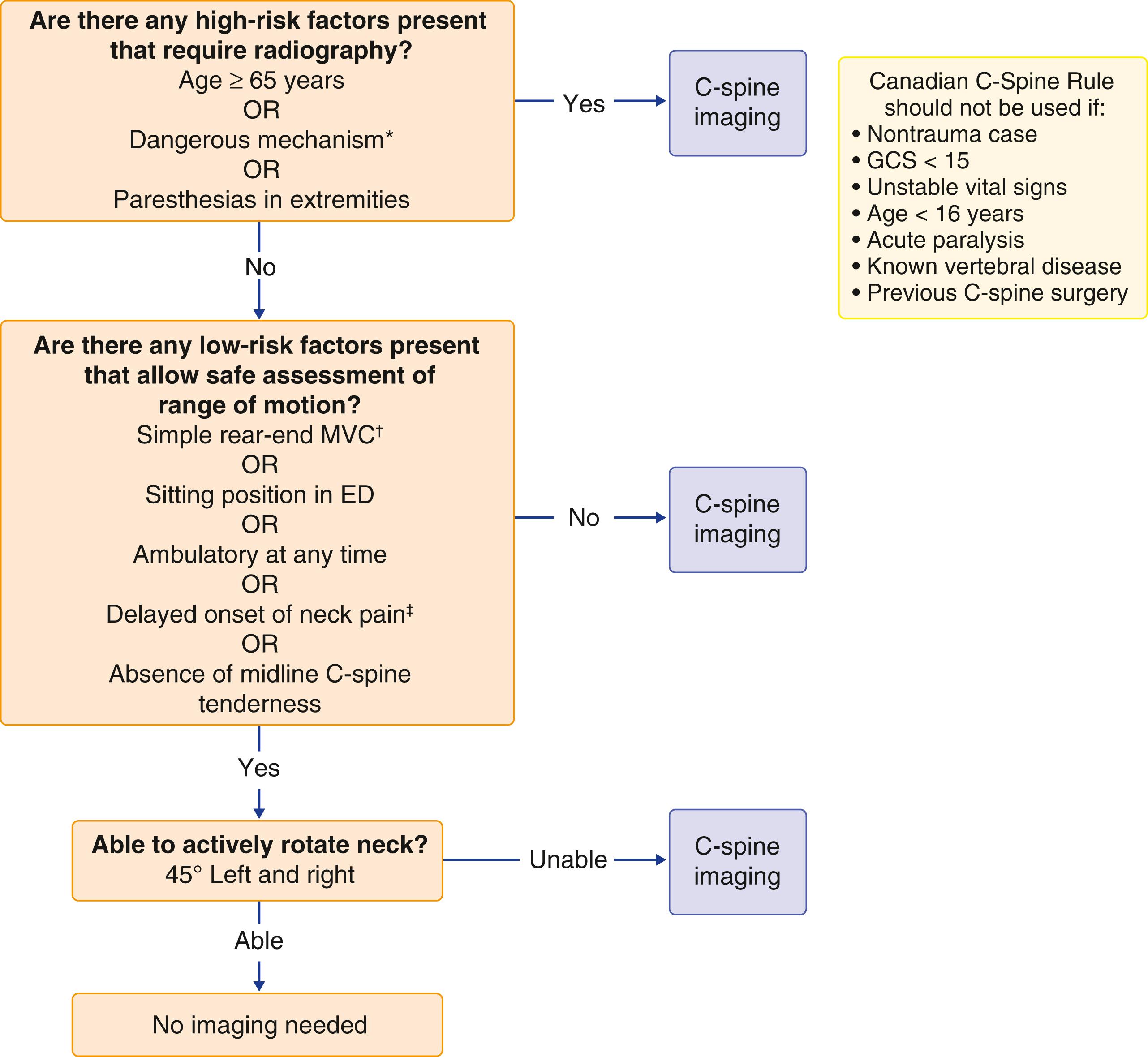Physical Address
304 North Cardinal St.
Dorchester Center, MA 02124
Traumatic brain injury and traumatic spinal cord injury are common preventable diseases. The majority of patients with traumatic brain and spinal cord injuries are young adult males. Hospitalization for traumatic brain injury is more common in urban areas, whereas brain injury-related deaths are more common in rural areas.
An estimated 54 to 60 million people sustain a traumatic brain injury worldwide each year, and it is projected to become the third largest cause of disease burden worldwide by 2020. Low- and medium-income countries have nearly three times more traumatic brain injuries per capita than do high-income countries, with the greatest overall burden in Southeast Asia and the Western Pacific. The predominant mechanism of injury varies geographically, from road traffic accidents in Africa and Southeast Asia (both 56%) to violence in South America, the Caribbean, and sub-Saharan Africa. In the United States, traumatic brain injury results in over 2.5 million emergency department visits and 52,000 deaths each year, thereby making it the single leading cause of traumatic death and disability ( Chapter 97 ). Between 2000 and 2015, over 300,000 soldiers were diagnosed with traumatic brain injury, and estimates of sports-related traumatic brain injury range from 1.6 to 3.8 million annually. The prevalence of traumatic brain injury in the U.S. population is estimated at 5 million, but the magnitude is likely greater because this injury is often underreported by patients and overlooked by acute care providers. Over 85% of all traumatic brain injuries are mild injuries, commonly known as concussions. The majority of traumatic brain injuries are due to falls ( Chapter 24 ), motor vehicle accidents, and assaults.
The prevalence of spinal cord injury in the United States is estimated at about 240,000 to 350,000, with approximately 12,500 new severe spinal cord injuries occurring each year. About one third of all spinal cord injuries result in complete paraplegia or tetraplegia. Spinal cord injuries most commonly result from motor vehicle collisions, falls, assaults, and sports-related injuries ( Chapter 97 ).
In traumatic brain injury, this phase refers to parenchymal injuries that result from the mechanical forces acting on the brain. These forces include direct linear acceleration as well as rotational acceleration due to movement of the head on the neck, which acts as a fulcrum for this rotation. Direct acceleration results in direct impact, which can damage parenchymal structures beneath the impact (with or without skull fracture), as well as structures on the opposite side as the brain recoils and strikes the inner aspect of the skull (coup-contrecoup lesion). Rapid head rotation puts stretch forces (i.e., strain) on neuronal axons and blood vessels, which are uniquely susceptible owing to their elongated microstructure. The result of these mechanical forces is axonal injury, intracranial hemorrhage, and disruption of the blood-brain barrier, all of which can contribute to an increase in the volume of intracranial contents. Because the brain is enclosed within the confines of a rigid skull, even a small increase in volume can raise intracranial pressure and result in reduced cerebral perfusion pressure, unless there is a compensatory increase in mean arterial blood pressure. This relationship is expressed by the following equation: cerebral perfusion pressure equals mean arterial pressure minus intracranial pressure.
In the uninjured brain, cerebral autoregulation keeps cerebral perfusion pressure relatively constant over a range of mean arterial pressures (50 to 170 mm Hg) to meet the brain’s high metabolic demands. Autoregulation is accomplished primarily through dynamic control of cerebral blood flow and cerebrovascular resistance, which are related to cerebral perfusion pressure in the following way: cerebral blood flow equals cerebral perfusion pressure divided by cerebral vascular resistance. In the injured brain, this autoregulatory process is often impaired, such that sudden increases in mean arterial pressure may be directly translated to spikes in cerebral perfusion pressure, which can worsen existing hemorrhage or contribute to secondary hemorrhage. By comparison, decreases in mean arterial pressure can reduce cerebral perfusion pressure, thereby resulting in neuronal ischemia and necrosis, as well as brain edema.
Uncontrolled increases in intracranial pressure can cause swollen sections of brain tissue to herniate around or through rigid skull structures, such as the falx cerebri, the tentorium cerebelli, and the foramen magnum. High pressure contact with these structures compromises local blood flow and leads to tissue death. The most common brain herniation is uncal herniation, which results when the innermost aspect of the temporal lobe swells over the free edge of the tentorium cerebelli, thereby compressing the midbrain pyramidal tract and parasympathetic fibers in the oculomotor nerve. Herniation of the cerebellar tonsils through the foramen magnum compresses the medulla or pons against the odontoid process and can result in sudden death.
In spinal cord injury, this phase refers to injury to the cord and blood vessels as a result of direct mechanical forces on the vertebral column. These forces cause hemorrhage and edema at the site of injury.
The secondary injury phase of traumatic brain injury involves progression of axonal injury, a neuroinflammatory response, and reduced glymphatic clearance of potentially toxic metabolites, all taking place over days to weeks and even months post-injury. Progression of axonal injury involves shifts in ionic flux, destruction of intra-axonal structures, axonal swelling, and mitochondrial failure, with resulting loss of axonal transport and altered neurotransmission ( E-Fig. 368-1 ). Affected neurons may undergo demyelination and/or apoptosis (programmed cell death). A neuroinflammatory response involving microgliosis starts within hours of injury and may continue for months or even years.
The secondary injury phase of traumatic spinal cord injury involves vasospasm and thrombosis of small arterioles, thereby resulting in extension of cord edema. After spinal cord injury, the process of neuronal degeneration is similar to what happens with traumatic brain injury. Injury-induced disruption of the blood-brain barrier allows elements of the peripheral immune system to instigate and sustain persistent abnormal neuroinflammation. The destruction of intra-axonal structures can result in release of neurotoxic proteins, such as beta-amyloid and phosphorylated tau, which accumulate because of reduced glymphatic clearance.

The clinical hallmark of acute traumatic brain injury is an alteration in the level of consciousness, as indicated by a loss of consciousness, amnesia, confusion, and/or disorientation at the time of injury. Clinical manifestations vary depending on the severity of the injury.
Patients with mild traumatic brain injury (concussion) may experience a brief loss of consciousness (<30 minutes) or have a period of amnesia (repeating questions to providers) or confusion persisting for less than 24 hours. The physical examination is notable for the absence of signs of increased intracranial pressure or brain herniation. Vomiting, seizures, or signs of skull fracture should raise suspicion for intracranial hemorrhage, which can occur in up to 5 to 10% of patients with mild traumatic brain injury.
Patients with moderate to severe traumatic brain injury have readily recognizable reductions in the level of consciousness, ranging from confusion to agitation to somnolence persisting for at least 24 hours.
More severe brain trauma is typically assessed by the Glasgow Coma Scale ( Table 368-1 ), which measures eye opening, verbal response, and motor responses to spoken commands or tactile stimulation. The physical examination may reveal signs of elevated intracranial pressure such as Cushing reflex (increased blood pressure, bradycardia, and irregular respiratory rate), vomiting, and decorticate or decerebrate posturing. Signs of uncal herniation include an ipsilateral fixed and dilated pupil with contralateral motor paralysis, whereas cerebellar tonsillar herniation results in midsized unreactive or pinpoint pupils and flaccid paralysis. Signs of open/depressed skull fracture or basilar skull fracture (hemotympanum, cerebrospinal fluid rhino/otorrhea, periorbital ecchymosis, postauricular ecchymosis) are often associated with intracranial hemorrhage. Focal cerebral injury may manifest as seizures or focal limb weakness/numbness.
| BEST MOTOR RESPONSE | BEST VERBAL RESPONSE | BEST EYE OPENING |
|---|---|---|
| 1 = No motor response | 1 = No verbal response | 1 = No eye opening |
| 2 = Extension to pain | 2 = Incomprehensible sounds | 2 = Eye opening to pain |
| 3 = Flexion to pain | 3 = Inappropriate words | 3 = Eye opening to verbal command |
| 4 = Withdrawal from pain | 4 = Confused | 4 = Eyes open spontaneously |
| 5 = Localizes pain | 5 = Oriented | |
| 6 = Obeys commands |
After resolution of the acute alteration in consciousness, most patients with traumatic brain injury experience one or more symptoms such as headache, dizziness, difficulty with memory and concentration, difficulties with balance, and fatigue. These symptoms reflect axonal injury to functional brain networks regulating head and neck pain, sleep, mood, attention, short-term memory, vestibular function, and near vision. On physical examination, patients with traumatic brain injury may display abnormal postural stability, unsteady tandem gait, abnormal smooth pursuit or saccadic eye movements, abnormal vestibulo-ocular reflex, convergence insufficiency, or accommodative insufficiency. Neurocognitive testing may reveal deficits in immediate and delayed recall, concentration, information processing, executive functioning, and reaction time. In addition, patients who survive moderate-severe traumatic brain injury can have deficits of motor function, sensation, and language.
The three main spinal cord syndromes are Brown-Séquard, central cord, and anterior cord syndromes. In Brown-Séquard syndrome, the deficits are referable to a lesion of a lateral half of the cord; findings consist of loss of ipsilateral motor, touch, proprioception, and vibration sensation, as well as contralateral loss of pain and temperature sensation. Central cord syndrome is manifested as bilateral loss of motor function involving the upper extremities but sparing the lower extremities and is sometimes referred to as “man in a barrel syndrome.” Proximal weakness is greater than distal weakness. Pain and temperature sensation is reduced, whereas proprioception and vibration are usually spared. Anterior cord syndrome is manifested by deficits referable to bilateral anterior and lateral spinal cord columns or funiculi. There is loss of touch, pain, and temperature sensation and motor function below the level of the lesion, but the posterior column functions of proprioception and vibratory sensation remain intact.
After acute traumatic spinal cord injury, patients may suffer from spinal shock or temporary loss of spinal reflexes below the level of injury, including loss of muscle stretch reflexes, the bulbocavernosus reflex, and the anal wink. In high cervical injuries, the lower reflexes (bulbocavernosus reflex and anal wink) may be preserved. Some patients demonstrate the Schiff-Sherrington phenomenon, in which reflexes are affected above the level of injury. Patients with spinal shock also may lose autonomic reflexes, thereby leading to neurogenic hypotension, peripheral vasodilation, ileus, and urinary retention. If the lesion is at T3 or above, sympathetic tone to the heart is compromised. In this setting, hypotension is accompanied by bradycardia, thus producing dysautonomia and the neurogenic shock triad of bradycardia, hypotension, and peripheral vasodilation.
The diagnosis of traumatic brain injury is primarily clinical. Two necessary elements are experiencing an injury and having an alteration in the level of consciousness (confusion, disorientation, amnesia, loss of consciousness) at the time of injury. Physical examination and neuroimaging can substantiate the initial clinical impression and determine the severity of the injury, but neither is sensitive enough to exclude traumatic brain injury. Alterations in the level of consciousness are readily recognized in severe traumatic brain injury but are more difficult to detect in milder forms. A standardized protocol ( Table 368-2 ) can help first responders identify more subtle alterations in the level of consciousness.
| TASK | POSSIBLE SCORE |
|---|---|
| ORIENTATION | |
| Month, date, day of week, year, time (1 point for each correct answer) | 0-5 |
| IMMEDIATE MEMORY | |
| Patient repeats a five-word list spoken by examiner; three trials (1 point for each word correctly remembered) | 0-15 |
| CONCENTRATION | |
| Digits backward; three-, four-, five-, and six-digit strings (1 point for each digit string correctly repeated backward) | 0-4 |
| Months of the year in reverse order (1 point for repeating backward in correct sequence) | 0-1 |
| DELAYED MEMORY RECALL | |
| Patient repeats the five words from Immediate Memory test (1 point for each word correctly recalled) | 0-5 |
| TOTAL SCORE | 0-30 |
The Glasgow Coma Scale score (see Table 368-1 ) should be calculated to estimate the severity of the traumatic brain injury.
All patients with a Glasgow Coma Scale score (see Table 368-1 ) below 15 should have a noncontrast computed tomography (CT) scan of their head to detect clinically important intracranial injuries such as trauma-related fractures, hemorrhage, and brain tissue swelling. Early detection of expanding hemorrhage is key for rapid neurosurgical decompression, which can be lifesaving. For patients with a Glasgow Coma Scale score of 15, in whom the prevalence of intracranial injury is less than 10%, clinical decision rules can be used to identify high-risk patients in need of head CT scanning ( Table 368-3 ). Typical postinjury CT findings include subdural hematoma ( Fig. 368-1 ), epidural hematoma, intraparenchymal hemorrhage, contusion, and traumatic subarachnoid hemorrhage ( Chapter 377 ). An associated skull fracture, especially at the temporoparietal junction, increases the likelihood of epidural hematoma, usually by disruption of the middle meningeal artery. Magnetic resonance imaging (MRI) is a more sensitive test that can detect subtle changes not visible on CT. Most patients with mild traumatic brain injury will have normal neuroimaging, because axonal injury is largely invisible on CT and standard MRI. However, susceptibility weighted MRI can detect microhemorrhages, and diffusion tensor imaging can visualize disrupted white matter tracts.
| INDICATION FOR CT SCANNING | CANADIAN | NEW ORLEANS | ACEP |
|---|---|---|---|
| GCS | <15 at 2 hr | <15 | <15 |
| Amnesia | Retrograde >30 min |
Anterograde | Any |
| Suspected skull fracture | Yes | Yes | Yes |
| Vomiting | Recurrent | Any | Any |
| Age | ≥65 | >60 | >60 ∗ |
| Coagulopathy | — | — | Yes |
| Focal deficit | — | — | Yes |
| Seizure | — | Any | Yes |
| Loss of consciousness | If GCS = 14 | — | Yes? |
| Visible trauma above the clavicles | — | Any | Any |
| Headache | — | Yes | Yes |
| Dangerous injury mechanism † | Yes | — | Only if no LOC |
| Suspected intoxication | — | Drug, alcohol | Drug, alcohol |
| Sensitivity/specificity ‡ | 0.99/0.51 | 0.99/0.33 | Unknown |
∗ Age >65 if no loss of consciousness; otherwise, positive only if loss of consciousness or amnesia.
† Pedestrian vs. motor vehicle, ejection from motor vehicle, fall from height >1 m or five stairs.
‡ For detection of traumatic intracranial injury on head CT scan.

Elevations in blood-based brain biomarkers (e.g., ubiquitin carboxyl-terminal hydrolase isozyme L1 precursor and glial fibrillary acid protein) can aid in the decision to obtain a head CT scan in patients with mild traumatic brain injury. Used in combination (i.e., a positive test is defined by an elevation of either or both proteins, whereas a negative test is defined by neither protein being elevated), these proteins have a sensitivity of about 98% and specificity of 99.6% for predicting the presence of traumatic intracranial lesions on CT.
A detailed neurologic examination is needed to identify the level of the injury and the severity of any deficits, as well as to document the degree of neurologic dysfunction at the earliest time possible. The level of the injury is the lowest spinal cord segment with intact motor and sensory function. Normal neurologic findings in patients with a clear sensorium obviate the need for imaging studies. However, any complaints of pain over the spine, numbness, tingling, or weakness should raise suspicion of spinal cord injury. In particular, a complaint of “burning hands” suggests traumatic spinal cord injury.
The time of injury should be recorded as accurately as possible. The prognosis for neurologic improvement is better if the lesion is incomplete as opposed to complete. During the acute period, serial examinations must be performed frequently.
If spinal cord injury is suspected, the patient should be appropriately immobilized, such as with a rigid collar and back board. In patients who are able to cooperate with a neurologic examination, are not intoxicated, and do not have painful distracting injuries (e.g., femoral fracture, which would interfere with the leg motor and sensory examination), normal neurologic findings effectively exclude cervical spinal cord disease.
In patients who are alert and stable, the Canadian C-Spine Rule ( Fig. 368-2 ) can be used to reduce unnecessary spinal imaging without any adverse effect on patients’ outcomes. In other patients, the radiologic evaluation should begin with plain radiographs of the bony spine, with further neuroimaging of any abnormalities that are found. Bony vertebrae should be examined with CT, whereas the spinal cord and intervertebral and paravertebral soft tissue are best studied with MRI. After blunt trauma, negative results from a well-interpreted, high-quality CT scan is probably a safe and efficient way to exclude cervical spine injury in obtunded patients. A chest radiograph is usually indicated to provide images of the lower cervical and thoracic vertebrae; the presence of a pleural effusion in the setting of a possible thoracic spine injury suggests a hemothorax.

If plain radiographs and CT of the cervical spine are normal but the patient still complains of neck pain, a ligamentous injury should be considered. Patients should be kept in a rigid cervical collar until one of the following conditions is met: (1) pain and muscle spasm resolve, (2) dynamic flexion/extension radiographs are normal, or (3) MRI obtained within 48 hours of injury is normal. Abnormal imaging or persistent pain warrant surgical evaluation to determine whether further immobilization or surgical correction is necessary.
The approach to treatment varies based on the severity of the injury.
Become a Clinical Tree membership for Full access and enjoy Unlimited articles
If you are a member. Log in here